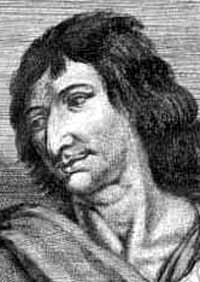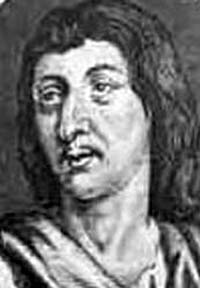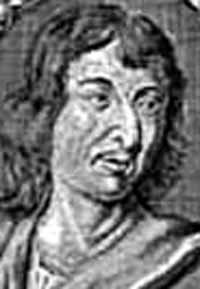(c) Michael D. Robbins 2005
Astro-Rayological
Interpretation & Charts
Quotes
Biography
Images and Physiognomic Interpretations
It is clear from Edmond Rostand’s horoscope that he (despite his pursuits as a lawyer and journalist) was a true romantic, just like his leading character. His Aries Sun is conjunct with sixth ray Neptune in the seventh house of relationships. Neptune, further, is the veiled esoteric ruler of the Virgo Ascendant, and so, is connected with the energy of Christ-love. The great love of the hero, Cyrano, for Roxanne, was deep, true, abiding and sacrificial—utterly devoted and yet the seed of the kind of wider and selfless love demonstrated by the Great Teacher, the Christ. As if the Sun/Neptune emphasis were not enough, sixth ray Mars is conjunct second ray Jupiter in Pisces (a sign which transmits both the sixth and second rays). Mars is strengthened, (just as Neptune was) because it is the exoteric ruler of the Sun Sign.
The Mars/Jupiter conjunction gives great enthusiasm and a strong solar-plexus/heart interplay; it is found conjunct the Pisces Descendant. This second conjunction places a tremendous emphasis upon the dynamics of relationship, bringing romantic passion (Mars in Pisces) and compassionate, selfless wisdom (Jupiter in Pisces). Interestingly, Chiron, like Jupiter, is almost exactly conjunct the Descendant, showing that there is a deep wound in the field of relationship, but that, through love and selfless devotion (Jupiter, Mars and Neptune), it can be healed. Even further stress in and emphasis upon relationship can be seen by the conjunction between conscientious Saturn and Juno (the asteroid of partnership). The Moon in Cancer gives that tenacity in devotion which remembers always and will not release. It is important to realize that an artist will work through his own psychological issues through the medium of his creations. A similar instance is the work of Cervantes in the love story, Don Quixote.
Whether or not the original and real-life Cyrano led a life resembling the literary Cyrano, he too was an ardent and enthusiastic lover (Mars in Aries almost exactly conjunct Venus, and the Moon in Aries conjunct Jupiter). The date of his birth is known, and a reasonable but speculative rectification places ardent Leo on the Ascendant, emphasizing the importance of the Sun in romantic Pisces—the sign in which Rostand’s Jupiter, Mars, Mercury and Chiron are found. The deadliness of the actual Cyrano’s blade would be indicated by Pluto at the MC, and his poetry by Neptune in the third house of communication—a Neptune given added weight because it is the veiled esoteric ruler of his speculative Ascendant Leo. Further, romantic, sixth ray Neptune would be in the sign of relationship and marriage, Libra. Both men—Rostand and the real Cyrano—would then have Neptune (with its emphasis on selfless love) as the veiled esoteric ruler of the Ascendant. As an interesting side note, the “Uranian Planet” Hades (23º Taurus), which can indicate ugliness or deformity, is, in the speculative chart of the real Cyrano exactly square to his relationship axis at 23º Leo/Aquarius. Further, just as in the case of Rostand, the real Cyrano would have wounding Chiron in the seventh house of relationship. These are interesting potential parallels.
In the life of Edmond Rostand, although the poetic fourth ray would be of importance, and has conduits through the Taurus planets (Venus and Pluto) and the Sagittarius planet (Saturn), the sixth ray is of overpowering importance. Each of the three signs conveying this ray is strongly represented in Rostand’s chart—the Virgo Ascendant, the Sagittarian Saturn, and the Piscean Jupiter, Mars, Mercury and Chiron.
Combining the testimony of the chart with the play and character upon which his reputation rests, one might say that the purpose of the incarnation was to develop and nurture the germ of Christ-love through the garnered wisdom of sacrificial, devoted, painful, personal love.
A kiss is a rosy dot over the 'i' of loving.
The insufferable arrogance of human beings to think that Nature was made solely for their benefit, as if it was conceivable that the sun had been set afire merely to ripen men's apples and head their cabbages.
I may climb perhaps to no great heights, but I will climb alone.
A large nose is the mark of a witty, courteous, affable, generous and liberal man.
Perish the Universe, provided I have my revenge.
A kiss is a rosy dot over the 'i' of loving.
A large nose is the mark of a witty, courteous, affable, generous and liberal man.
Less interested in the scientific fundamentals of rocketry, many writers of popular literature and science fiction discovered one of the most vital elements in the formula for space travel, a fertile imagination. Under the impression that the sun "draws up" dewdrops, Cyrano de Bergerac suggested fancifully that one might fly by trapping dew in bottles, strapping the bottles to oneself, and standing in sunlight.
Savinien Cyrano de Bergerac (March 6, 1619 – July 28, 1655) was a French dramatist born in Paris, who is now best remembered for the many works of fiction which have been woven around his life story.
Cyrano was born into an old Parisian family and spent much of his childhood in Saint-Forget (now Yvelines). He went to school in Paris and spent his adult life there when he was not on campaign. He was not, therefore, a Gascon, but many of his fellow-soldiers would have been. The myth of his Gascon origins may even have been cultivated by him during his lifetime, since the swash-buckling manners of the Gascon soldiers were much admired in his day.
Cyrano de Bergerac was not a hugely talented writer, but the Rostand line about his works being stolen by Molière probably has some basis in fact. His most prominent work is now published under the title 'otherworlds' and is a collection of stories describing his fictional journeys to the Moon and Sun. The methods of space travel he describes are inventive and often ingenious, detailing ideas often broadly original and sometimes rooted in science. Cyrano rests alongside such minds as Kepler and Jules Verne under the genre of 'scientific travel fiction'. In his time, de Bergerac was a popular poet; however, his abilities were much exaggerated by Rostand in his dramatic work. Cyrano was expert, however, in the art of dueling, whether from a touchy disposition or because of the many gibes to which he was subject on account of his appearance is uncertain. The real Cyrano did not have an exceptionally big nose, but that has become the prominent feature in all fictive versions of his life.
No Roxane has been discovered in his life, but he did fight at the Battle of Arras, where the historical Baron of Neuvillette, who was in fact married to Cyrano's cousin, died.
Cyrano was a free thinker, although he was a pupil of Pierre Gassendi, a Canon of the Catholic Church, albeit one who tried to reconcile Epicurean atomism with Christianity. Cyrano had the insistence on reason that was not common until the following century, and he would have been very much at home in the Enlightenment. This, of course, did not fit well in a period in which the Church and the State were supreme, and when even the laws of art were the rules of Aristotle.
He died in Sannois at the age of 36.
Cyrano de Bergerac in fiction
In 1897, the French poet Edmond Rostand published a play, Cyrano de Bergerac, on the subject of Cyrano's life. This play, by far Rostand's most successful work, concentrates on Cyrano's love for the beautiful Roxane, whom he is obliged to woo on behalf of a more conventionally handsome, but less articulate, friend, Christian de Neuvillette, with whom she already is in love.
The play has been translated and performed many times, and is responsible for introducing the word panache into the English language. It has been the subject of several films, including a 1950 film starring José Ferrer (for which he won an Academy Award), a 1990 French-language version starring Gérard Depardieu, and a comedic Hollywood version, Roxanne, starring Steve Martin.
A fictionalized version of Savinien Cyrano de Bergerac is one of the main characters in Philip José Farmer's Riverworld novels.
French satirist and dramatist whose works combining political satire and science-fantasy inspired a number of later writers. He has been the basis of many romantic but unhistorical legends, of which the best known is Edmond Rostand's play Cyrano de Bergerac (1897), in which he is portrayed as a gallant and brilliant but shy and ugly lover, possessed (as in fact he was) of a remarkably large nose.
As a young man, Cyrano joined the company of guards and was wounded at the Siege of Arras in 1640. But he gave up his military career in the following year to study under the philosopher and mathematician Pierre Gassendi. Under the influence of Gassendi's scientific theories and libertine philosophy, Cyrano wrote his two best known works, Histoire comique des états et empires de la lune and Histoire comique des états et empires du soleil (Eng. trans. A Voyage to the moon: with some account of the Solar World, 1754). These stories of imaginary journeys to the Moon and Sun, published posthumously in 1656 and 1662, satirize 17th-century religious and astronomical beliefs, which saw man and the world as the centre of creation.
Cyrano's use of science helped to popularize new theories; but his principal aim was to ridicule authority, particularly in religion, and to encourage freethinking materialism. He “predicted” a number of later discoveries such as the phonograph and the atomic structure of matter; but they were merely offshoots from an inquiring and poetic mind, not attempts to demonstrate theories in practical terms.
Cyrano's plays include a tragedy, La Mort d'Agrippine (published 1654, “The Death of Agrippine”), which was suspected of blasphemy, and a comedy, Le Pédant joué (published 1654; “The Pedant Imitated”). As long as classicism was the established taste, Le Pédant joué, a colossal piece of fooling, was despised; but its liveliness appeals to modern readers as it did to Molière, who based two scenes of Les Fourberies de Scapin on it. La Mort d'Agrippine is intellectually impressive because of its daring ideas, and the direct and impassioned character of the tragic dialogue makes it interesting theatrically.
As a political writer, Cyrano was the author of a violent pamphlet against the men of the Fronde, in which he defended Mazarin in the name of political realism as exemplified in the tradition of Machiavelli. Cyrano's Lettres show him as a master of baroque prose, marked by bold and original metaphors. His contemporaries regarded them as absurdly farfetched, but they came to be esteemed in the 20th century as examples of the baroque style.



